Understanding the Signs of a Burst Pipe and Rapid Repair Approaches
Understanding the Signs of a Burst Pipe and Rapid Repair Approaches
Blog Article
Are you currently trying to locate content concerning How to install a dishwasher safely?

A ruptured pipeline is a significant emergency; you can only stand as you watch water you pay dearly to reunite with the earth. In worse situations, you observe a pool on your kitchen floor, which is a fantastic journey danger, especially if you have youngsters around. If the pipeline that ruptured remained in your walls, problem: you may need to paint that whole area.
Exactly how can a disaster like a burst pipeline be protected against as well as handled? Well, by listening to your specialist emergency plumbing professionals and also following these rules.
Just how do I recognize when my pipelines have burst?
Fluctuating water stress
Pipelines do not just burst in a day. You may have seen that your kitchen area tap or shower does not run quickly when you turn the faucet. It might stop briefly for a few secs and afterwards blast you with more pressure than normal.
In other instances, the water might seem normal in the beginning, then drop in stress after a few seconds.
Damp walls and water discolorations
Before a pipe ruptureds, it will leakage, a lot of times. If this consistent dripping goes undetected, the leak might graduate right into a large gouge in your pipeline. One simple way to prevent this emergency is to watch out for damp wall surfaces advertisement water stains. These water discolorations will lead you right to the leakage.
Puddles under pipelines and sinks
When a pipeline ruptureds, the outflow forms a pool. It may appear that the pool is growing in size, and also regardless of how many times you wipe the puddle, in a few mins, there's one more one waiting to be cleaned. Commonly, you may not have the ability to map the puddle to any kind of visible pipelines. This is an indication to call a professional plumber.
Untraceable trickling noises
Pipeline ruptureds can happen in one of the most unpleasant areas, like within concrete, inside walls, or under sinks. When the house goes quiet, you may have the ability to hear an aggravatingly consistent trickling noise. Also after you've examined your shower head as well as kitchen faucet, the dripping might continue.
Precious reader, the leaking may be originating from a pipeline inside your walls. There isn't much you can do regarding that, other than tell a professional plumber.
Shut down the Water
When water freezes, it broadens in quantity by about 9 percent. As well as it increases with tremendous force: The stress inside pipelines may go from 40 extra pounds per square inch to 40,000 psi! No pipe can hold that much stress, so it bursts. The break may happen where the ice kinds, but more frequently, it happens where water stress finds a vulnerable point in the pipeline. That might be inches or even feet from the frozen location. Locate the water shutoff valve and turn off the water to avoid even more damages. You might likewise require to shut down the electrical energy too, depending on where the leaks takes place and exactly how large it is.
Contaminated water
Many people presume a ruptured pipe is a one-way outlet. Rather the contrary. As water spurts of the hole or gouge in your plumbing system, pollutants locate their way in.
Your water may be polluted from the resource, so if you can, examine if your water tank has any type of issues. Nonetheless, if your drinking water is supplied as well as cleansed by the local government, you should call your plumber instantly if you see or smell anything amusing in your water.
What do I do when I detect a ruptured pipe?
Your water meter will continue to run also while your water wastes. To lessen your losses, locate the main controls and also turn the supply off. The water mains are an above-ground framework beside your property.
How to Fix & Detect a Leaking Pipe
How Do I Know if a Pipe is Leaking?
Leak detection tests can help you determine if your pipe has a leak. Even if you don’t see an apparent leak, you should still conduct leak detection tests regularly to save water and money—and prevent major damage to your home.
Water meter. It can be helpful to figure out what your usual water meter usage numbers are and then monitor them regularly. To monitor your meter, first, turn off all water faucets in your home. Check the meter and write down the numbers. In a few hours, check the meter again. If the numbers have changed, you have a leak. Water gauge. Use a water gauge to test your water pressure. Your showerhead should produce a certain amount of water pressure based on its model and design. If the pressure is lower than it is supposed to be for that specific showerhead, your home likely has a leak. Puddles. Look inside your bathroom, laundry, and kitchen sink cabinets. Puddles around the cabinets or around toilets, tubs, showers, and washing machines indicate the presence of a leaking pipe. You may also notice loose tiles, peeling or flaking paint, or mold caused by water accumulation. Napkin test. Even if you don’t see any puddles, you may still have a leak. You can test for water leaks in the bathroom, laundry, and kitchen by wiping below-sink connections with a napkin, paper towel, or piece of toilet paper. If it becomes damp, you probably have a leaking pipe under the sink. Discolored walls. Walls that are discolored—usually with brown or yellow stains—or bulging might mean that they have been impacted by water damage caused by a leaking pipe. Smell. A leaky pipe will create sitting water, and over time, that water may develop a musty smell. If your home smells musty, but you can’t locate the source, it may be due to a leak. Steps for Fixing a Leaking Pipe
A leaky drain can be remedied by tightening the pipe base, replacing the drain seal, caulking the rim, and tightening the pipe nut. Similarly, a leaking toilet pipe can be treated by tightening the packing nut. You may also need to replace the valve. A leaky faucet may just need tightening or replacement of the washers. If that doesn’t work, consider replacing your faucet. If your pipe has a hole in it, you may want to use a pipe leak sealer or pipe leak tape. This quick fix for water pipe leaks can also temporarily fix a copper pipe leak. https://www.ahs.com/home-matters/quick-tips/how-to-tell-if-pipes-are-leaking/

As a devoted reader about What to Know Before Installing a Dishwasher, I assumed sharing that excerpt was sensible. Feel free to take a moment to share this page if you appreciated it. I recognize the value of reading our article about How to install a dishwasher safely.
Get An Estimate
Report this page